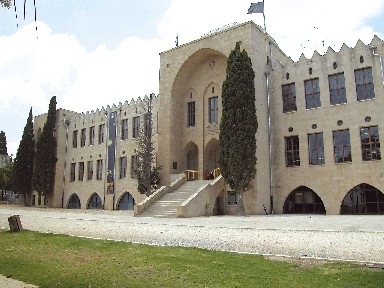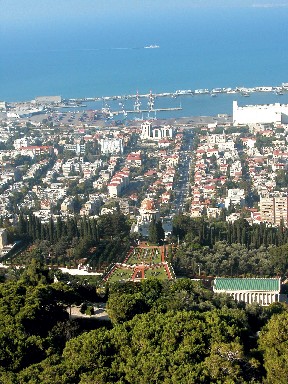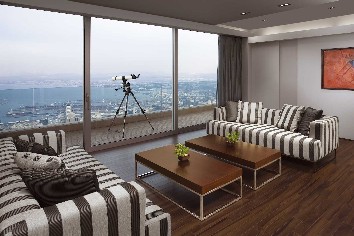|
ERETZ Magazine
|
Stayput Haifa
The city of the Carmel extends over the slopes
of the green mountain as it plunges into Haifa Bay. With the grand,
gold-domed Bahai Temple on the slope of the mountain and the
renovated German Colony at its foot, Haifa has more than a few
places of interest.
Contrary to popular opinion, there’s much more
to Haifa than the Bahai temple and gardens. The city itself,
extending from the busy port and broad beaches at the edge of the
sea to the top of the Carmel mountain range, is picturesque,
beautiful, and has a long, interesting history. Haifa’s German
Colony, which was established by Templers (a German Christian
movement that believed its destiny was in the Holy Land) in 1869,
has been restored and has become a thriving entertainment center
with gourmet restaurants, unique cafes, and lively pubs. Haifa is
home to at least a dozen museums, from the National Museum of
Science, Planning and Technology to the Tikotin Museum of Japanese
Art, and the National Maritime Museum. Haifa University and the
Technion – Israel Institute of Technology attract academics,
students, and businesspeople to town. The Beit Hagefen cultural
center reflects the diversity of Haifa’s residents.
Haifa also is an ideal home base for tourists who want to tour
northern Israel, but stay in a first-rate hotel in a modern city. It
is within minutes by car of colorful Druze villages, a half-hour
drive from Rosh Hanikra and Zichron Ya’acov, and just over an hour
drive from Safed and Tiberias.
(Back to top)
Museums
Druze Heritage House
The Druze Heritage House used to be the home of
the British Christian Zionist Laurence Oliphant. Naphtali Herz Imber,
composer of Hatikvah, lived there for a while. Visitors can see an
exhibit focusing on the life of the Druze community: tools, weapons,
clothing, foods, and more. There are also lectures, a film about the
history of the Druze and Mt. Carmel, and a tour in the village.
Daliyat el-Carmel, Tel. (04) 839-3242.
(Back
to top)
Haifa City Museum
The Haifa City Museum is located in the German
Colony, in a stone building constructed by the Templers, a German
Christian movement whose members settled in the Land of Israel in
the second half of the nineteenth century. The building has been
restored and reconstructed. The museum presents a wide variety of
temporary exhibitions on different themes. 11 Ben-Gurion St., Haifa,
Tel. (04) 851-2030 or (04) 852-3255.
(Back
to top)

Haifa Naval Museum
This museum features two complementary
exhibits: one focusing on the clandestine immigration and the other
focusing on the Israeli navy. The architectural structure
incorporates an original immigrant ship. The exhibits depict the
struggle of the people of Israel in the pre-State period for the
right to settle in the Land of Israel and the development of the
Israeli navy to this day. 204 Allenby St., Haifa, Tel. (04)
853-7672.
(Back
to top)
The Edible Oil Industry Museum
This museum, founded in 1984, is located in a
historic building. It views the edible oil industry in all its
aspects and encourages the study of the subject.The museum’s
courtyard features a display of reconstructed olive presses from
biblical times, the Byzantine period, and the early 1900s. Visitors
can try their hand at operating various equipment. 2 Tovim St.,
Shemen Beach, Tel. (04) 865-4333.
(Back
to top)
Haifa Railway Museum
The Railway Museum, located in the Haifa East
station, depicts milestones in the development of rail transport in
the Land of Israel. Among the items on display are a salon car that
was used by the high commissioner and the guests of the government
in British Mandate Palestine, a machine from the 1930s for the
printing of tickets, timetables and tickets from various periods,
models, an electric train set, and plans for the development of the
railway. The museum is housed in a building which served at the
beginning of the twentieth century as a terminal for the
Haifa-Damascus line.
Haifa East railway station, Tel. (04) 856-4293.
(Back
to top)
Shopping in Haifa
The Kastra Center in Haifa offers a unique,
artistic, cultural, and shopping experience. The center is named
after the ancient city that was discovered in an archaeological
expedition in the area. Some of the finds are on display, alongside
paintings, sculptures, and other objets d’art. The center has
wonderful galleries, jewelry stores with extraordinary pieces, and
designer clothing boutiques. The highlight of a trip to the center
is a visit to Shokoshop, an excellent chocolate boutique that
carries pralines with a huge variety of flavors and fillings, from
hazelnut mouse to guava (Kastra Center, 8 Flieman Street, Haifa,
Tel. (04) 850-0518).
The Druze village of Daliyat el-Carmel is located just outside of
Haifa. It is full of great restaurants that serve excellent Druze
cuisine. It also has a market that attracts visitors from the entire
region with its wide variety of antiques, rugs, furniture, ethnic
clothing, housewares, and handmade art and decorative objects.
(Back
to top)
Dining in Haifa
The gourmet restaurant trend that is sweeping
across Israel has not skipped Haifa. One example of this is Hanamal
24, which serves excellent French Mediterranean cuisine with a local
twist. It may be the only place where one can taste kubbeh filled
with crab and served with okra in tomato sauce (24 Hanamal Street,
Tel. (04) 862-8899, not kosher).
Haifa also is a great place to enjoy authentic Druze and Arab
cuisine. Some even say that the falafel served up at Felafel
Hazakanim in Haifa’s Wadi Nisnas neighborhood is the best in Israel
(18 Wadi Nisnas, not kosher). The restaurant at Ein Hod not only
serves excellent Arab food, but also has a great view of the Carmel.
It is considered one of the best restaurants in Israel, but is warm
and unpretentious (Ein Hod, Tel. (04) 839-7350, not kosher).
(Back
to top)
The Bahai Center
The spiritual and administrative center of the
Bahai faith is located in Haifa. The Bahai faith is an international
religion stemming from Shiite Islam. The faith is named after one of
the founders of the faith, the Bah Allah (Splendor of God). The
forerunner of the faith, Mirza Ali Muhhamed, started to preach his
beliefs in Persia in 1844. He was executed in 1850. The Bah Allah,
who followed him as the leader of the faith, was
exiled by the authorities to Baghdad, from there to Adrianople and
finally to Acre. At first, he was imprisoned in the Acre jail and
later spent his time at a mansion on the outskirts of the city. He
died in 1892 and is buried in the mansion, which is considered holy
by Bahais. Bah Allah showed his followers a place in Haifa, on the
slopes of Mount Carmel, where the the Bahai temple was to be built.
His eldest son, Abas Efendi, carried out the wishes of his father.
Efendi was buried in Haifa in 1921. Efendi’s son continued to spread
the faith. He lived in Haifa and built the Bahai World Center, which
includes the magnificent gold-domed tomb of the founders and the
beautiful gardens that extend down the slopes of the Carmel. started to preach his
beliefs in Persia in 1844. He was executed in 1850. The Bah Allah,
who followed him as the leader of the faith, was
exiled by the authorities to Baghdad, from there to Adrianople and
finally to Acre. At first, he was imprisoned in the Acre jail and
later spent his time at a mansion on the outskirts of the city. He
died in 1892 and is buried in the mansion, which is considered holy
by Bahais. Bah Allah showed his followers a place in Haifa, on the
slopes of Mount Carmel, where the the Bahai temple was to be built.
His eldest son, Abas Efendi, carried out the wishes of his father.
Efendi was buried in Haifa in 1921. Efendi’s son continued to spread
the faith. He lived in Haifa and built the Bahai World Center, which
includes the magnificent gold-domed tomb of the founders and the
beautiful gardens that extend down the slopes of the Carmel.
(photo: Tagist Ron)
(Back
to top)
Atlit
A national site, the Atlit “Illegal”
Immigration Detention Camp serves as an educational center for the
study of the ha’apala (“illegal” immigration) to the Land of Israel
and a memorial that commemorates the heroism of the fighters and the
immigrants who tried to enter Palestine in defiance of the British
blockade.
At the initiative of the Council for Restoration and Preservation of
Historic Sites in Israel, the disinfection center, some of the
barracks, and open areas and fences of the camp have been renovated
and reconstructed. On the site there are displays that depict life
in the camp, the life of the immigrants, and the ha’apala.
An audiovisual presentation is screened, there are interactive
multimedia games, and a historical library is available for
students’ reference. The Council for Restoration and Preservation of
Historic Sites in Israel holds a variety of activities at the site –
guided tours, study days, conferences, and special events.
At the end of 2001, the Ma'apilim Information Center and Database,
was inaugurated at Atlit. The database now contains information on
some 18,000 “illegal” immigrants. Tel. (04) 984-1980
(Back to top)
Itinerary
Day 1: Haifa
Start the tour at the Tikotin Museum of
Japanese Art, located on the summit of the Carmel. Make your way
down to the Bahai World Center, walk through the Persian gardens,
and visit the Bahai Temple (reservations required, Tel. (04)
831-3131). Descend the steps to the German Colony and explore the
quarter. Drive up the Carmel to the Stella Maris Monastery. Spend
the afternoon watching the crowds go by from one of the many coffee
houses on the Carmel.
(Back to top)
Day 2:
Mount Carmel
Take the road to Haifa University and continue
along the crest of the Carmel (Route 672) to the Druze village of
Daliyat el-Carmel. Stop at the market. On leaving the village, turn
left at the first junction and drive to the parking lot of the
Mukhraka monastery. Walk up to the monastery for a view of the
Jezreel Valley. This is the site where Elijah slew the prophets of
the Ba’al. Return to Route 672 and continue to the Eliakim Junction.
Take Route 70 to the west and at the junction to Zichron Ya’akov
take the road to the left up to the old Jewish settlement. Visit the
winery, the synagogue, and explore the shops along the pedestrian
mall. Drive down to Route 4 and at the Or Akiva Junction drive to
Caesarea to explore King Herod’s port.
(Back to top)
Day 3: Western Galilee
Take Route 4 to Acre. Explore the Crusader
town. Continue to Kibbutz Lohamei Hagetaot and visit the Ghetto
Fighters’ Museum. Continue north to the sea grottos at Rosh Hanikra.
Return along Route 4, stopping at Achziv for a swim in the
Mediterranean (May-November).
(Back to top)
Day 4: Sea of Galilee
Take Route 75 to Kiryat Tivon and continue on
Route 77 to Tiberias. Drive along the shore road for 11 km to the
turnoff to Kvutzat Kinneret. Drive up the road to the Yardenit
Baptismal Site. Return to the main road and continue to the entrance
to Kibbutz Deganiya Aleph. Drive into the kibbutz and visit the
Deganiya Courtyard, the site of the first kibbutz ever founded.
Drive south along Route 90 towards Beit She’an. After about 2 km,
turn right and drive to Kibbutz Sha’ar Hagolan for a visit to the
museum of prehistory. Drive along Route 92 to Kibbutz Ein Gev. Stop
at the kibbutz for a visit to the ancient anchor’s museum and lunch.
Continue north along the shore road (Route 92) to Kursi for a visit
to the Site of the Gerasene Demoniac (Kursi National Park). Take
Route 789 up to the Golan Heights. At kilometer marker 9, turn right
onto the dirt road with blue trail markings. Drive along the road to
the Mitzpe Ofir Lookout Point for a view of the lake. Continue south
along Route 769 to the Afik Junction and follow Route 98 along the
Southern Golan Plateau, and the hairpin curves that take you down to
the Hamat Gader hot springs. Follow Route 98 back to Zemah and take
Route 90 back to Tiberias.
(Back to top)
Day 5: Jerusalem
Take Route 2 to Tel Aviv, join up with 20 and
follow it to 1, which leads to Jerusalem. Enter the Old City via the
Jaffa Gate and visit the Tower of David history Museum. Walk down
David Street. Turn left onto Christian Quarter Street and walk down
the alley of Saint Helena to the Holy Sepulcher. Exit by the
entrance to the Muristan Market. Walk straight ahead until you reach
the busy market of Khan e-Zeit. Turn right and walk down the
Crusader markets. Turn left on David Street and make your way to
Sisileh Street. Walk down to the Kotel. Take the Rabbi Yehudah
Halevi steps to the Jewish Quarter. Walk to the Zion Gate. Outside
the gate turn right, and walk back to the Jaffa Gate.
(Back to top)
Day 6: Tel Aviv
Take Route 2 to Tel Aviv. Explore Jaffa.
Discover historic Tel Aviv by strolling through Neve Tzedek and
Rothschild Boulevard. Take a lunch break on Sheinkin and check out
the shops on Dizengoff Street. End the day with dinner on Ibn
Gabirol Street.
(Back to top)
Dan Hotels in Haifa
Haifa has much to offer visitors, including
three Dan Hotels: the Dan Carmel, the Dan Panorama Haifa, and the
Dan Gardens Haifa. All three are located in Haifa’s exclusive Carmel
neighborhood, high up on Mt. Carmel, and offer views of the
Mediterranean Sea, the Haifa Bay, and the Bahai’s sumptuous and
meticulously organized gardens. The Dan Carmel and the Dan Panorama
Haifa both were renovated recently, making them even more luxurious
than before.
The Dan Hotels in Haifa provide guests with all the conveniences of
a major city, while the greenery surrounding them, their amazing
views of Haifa, and their relaxing and romantic atmosphere make them
a lovely place to stay during a vacation.
 With
224 rooms, including 24 luxury suites, the Dan Carmel is considered
the most prestigious five-star deluxe hotel in northern Israel. It
is known for having the largest guest rooms in the Dan Chain – a
typical guest room is 34 sq.m., not including the private balcony.
The Dan Panorama Haifa is the tallest and largest hotel in the city,
with 266 rooms, including three suites, on 20 floors. It 550-sqm
fitness center is the largest of any hotel in Israel and can develop
personalized fitness programs for guests staying at the hotel for an
extended period. It is part of the Panorama Center, an expansive
complex which also includes an apartment tower and a mall with
designer stores. The newest member of the Dan family in Haifa, the
Dan Gardens Haifa, is a four-star hotel for guests who want to enjoy
the hospitality the Dan Chain is known for while staying within a
budget. This small, quiet hotel with only 31 rooms is geared more
for couples and businesspeople than families and groups. With
224 rooms, including 24 luxury suites, the Dan Carmel is considered
the most prestigious five-star deluxe hotel in northern Israel. It
is known for having the largest guest rooms in the Dan Chain – a
typical guest room is 34 sq.m., not including the private balcony.
The Dan Panorama Haifa is the tallest and largest hotel in the city,
with 266 rooms, including three suites, on 20 floors. It 550-sqm
fitness center is the largest of any hotel in Israel and can develop
personalized fitness programs for guests staying at the hotel for an
extended period. It is part of the Panorama Center, an expansive
complex which also includes an apartment tower and a mall with
designer stores. The newest member of the Dan family in Haifa, the
Dan Gardens Haifa, is a four-star hotel for guests who want to enjoy
the hospitality the Dan Chain is known for while staying within a
budget. This small, quiet hotel with only 31 rooms is geared more
for couples and businesspeople than families and groups.
Many of Haifa’s tourism sites and attractions are only a short walk
from the hotels.
(Back to top)
|
|